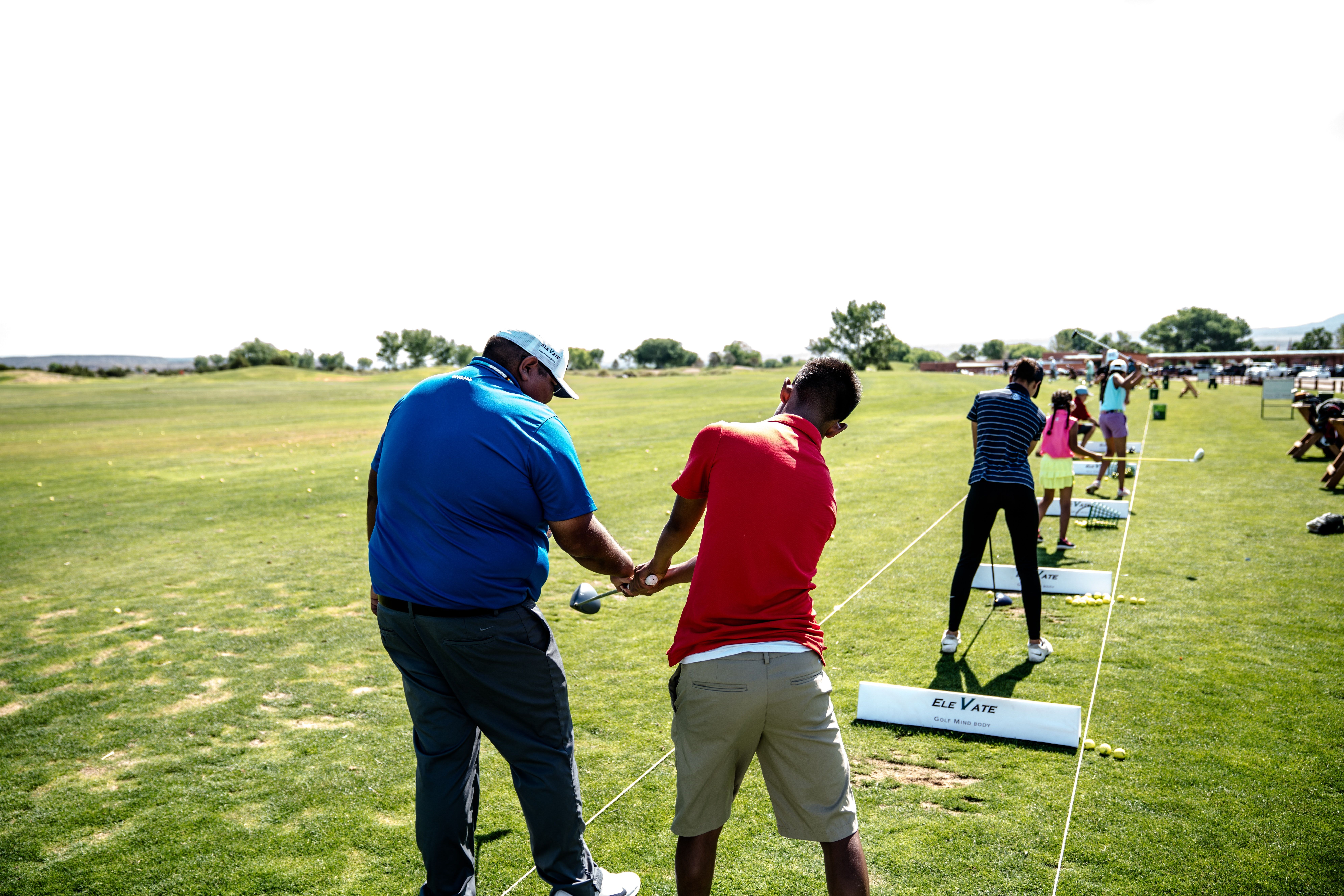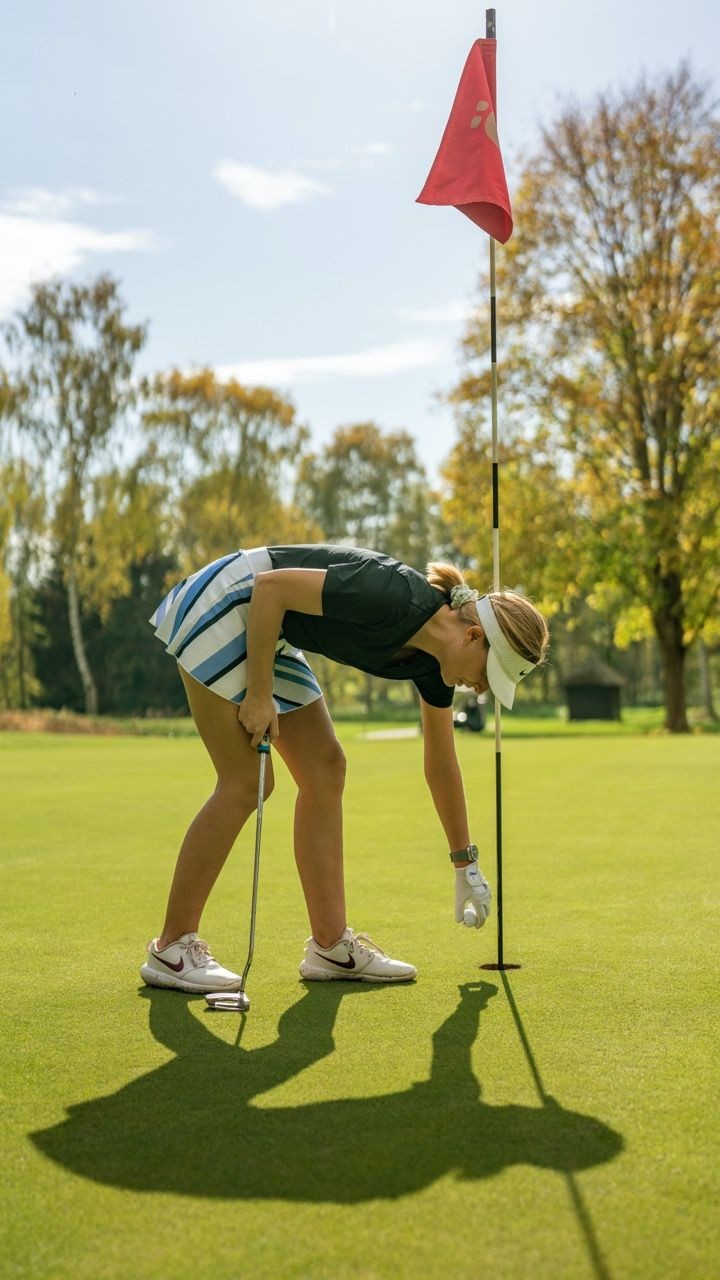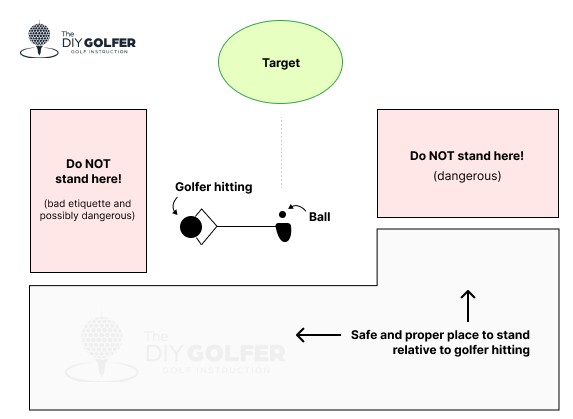Learning how to golf can seem daunting, but with the right approach, anyone can enjoy this rewarding sport. At LEARNS.EDU.VN, we believe that understanding the fundamentals, practicing consistently, and setting realistic expectations are the keys to success. This guide will walk you through each step, from selecting the right equipment to mastering basic techniques and finding enjoyment on the course. With the right strategies and resources, you can accelerate your progress and cultivate a lifelong love for the game of golf, enhancing your skills, understanding golf techniques, and improving your overall game.
1. Setting Realistic Expectations For Your Golf Journey
One of the biggest challenges in golf is having realistic expectations. The golf industry often overpromises instant results, but improvement takes time and effort. Be patient and focus on making consistent progress.
1.1 Understanding The Timeline For Game Improvement
Here’s a realistic timeline for improving your golf game, assuming you practice and play 1-3 days per week:
- Months 1-3: Frequent visits to the driving range and golf store. Missed shots and difficulty aiming. Feeling overwhelmed but experiencing occasional moments of success. The key here is not to give up.
- Months 3-12: More consistent shots at the driving range. Completing a few holes on the course without needing to pick up. Watching instructional videos, which can sometimes lead to confusion.
- Year 2: Golf becomes more enjoyable. Playing full rounds and keeping pace with experienced players. Focusing on scores and trying to break barriers like shooting under 100 or 90.
- Years 3+: Playing at nicer courses and enjoying golf trips. Upgrading equipment and understanding golf lingo. Becoming a true golfer with all the gadgets and apps.
2. Purchasing Beginner Golf Clubs And Accessories
Starting golf doesn’t require expensive equipment. Focus on getting a few essential clubs to get you started at the driving range and on the course.
2.1 Where To Buy Beginner Golf Equipment
Buying golf equipment can be overwhelming. Consider these options:
- Easy Way: Purchase a beginner golf set on Amazon for simplicity.
- In-Depth Way: Research extensively, compare individual clubs, and consider buying used equipment.
- Buying on Amazon simplifies the process. Beginner sets are designed to be forgiving and easy to use. As your skills improve, you can upgrade individual clubs to suit your specific needs and preferences.
2.2 How Many Clubs Do You Need?
- Beginner: 10-12 clubs are a good starting point.
- Upgraded: A full set of 14 clubs is the maximum allowed in golf.
- Most beginner sets on Amazon include a pitching wedge, sand wedge, irons, fairway wood, driver, and putter.
2.3 Recommendations for Club Sets
- 9/10/12-piece sets: These provide enough versatility for a beginner without being overwhelming.
- 14-piece set: A full set if you want to have every possible club available.
2.4 Essential Accessories
Besides clubs, you’ll need these essentials:
- Golf balls
- Golf shoes
- GPS App, GPS watch, or Rangefinder
- Accessories (tees, groove cleaner, towel, etc.)
2.4.1 Best Golf Balls For Beginners
Price is the primary concern for beginner golf balls, as you will lose many. The choice of golf ball won’t matter much until you start shooting below 100.
- Recommendation: Wilson Profile Distance golf balls (36-pack) – affordable and good quality.
2.4.2 Best Golf Shoes For Beginners
Golf shoes provide stability during your swing.
- Recommendation: FootJoy FJ Flex/Fuel golf shoe – comfortable with subtle spikes for grip.
2.4.3 Best GPS For Beginners
Measure distance from your ball to the hole to choose the right club.
- Free iOS or Android GPS App: The Grint, 18Birdies, and Garmin Golf apps.
- GPS Watch: Garmin S10.
- Laser Rangefinder: Bushnell Tour V5 (premium) or Gogogo Sport Vpro (budget).
2.4.4 Best Accessories For Beginners
Essential accessories include:
| Accessory | Description |
|---|---|
| Golf Tees | Used to elevate the ball on the tee box for the initial shot on each hole. |
| Golf Towel | For cleaning clubs and balls. |
| Groove Cleaner | To keep club grooves clean for better contact. |
| Ball Marker | To mark your ball’s position on the green. |
| Divot Repair Tool | To fix divots on the fairway and green. |








3. Learning The Basic Fundamentals Of The Golf Swing
Mastering the fundamentals is crucial for developing a consistent golf swing.
3.1 Key Fundamentals To Learn
Learn these fundamentals in the following order:
- Proper Golf Grip: The only connection you have with the club. Use a grip trainer. See our in-depth guide on how to grip a golf club.
- Chip Shot: A short game shot used around the greens.
- Pitch Shot: A longer short game shot, a “mini full swing.”
- Iron Shots: More challenging for beginners but essential.
- Full Swing Driver: Focus on smooth tempo, great posture, and solid contact.
- Bunker Shot: Learn the proper setup to escape from sand bunkers.
3.2 Best Ways To Learn Golf
Teaching yourself golf can be challenging. Consider these options:
3.2.1 Group Lessons
Affordable and hands-on instruction with golfers at the same skill level.
3.2.2 Private Golf Lessons
Personalized instruction from a golf instructor, typically costing $400-600 for 6-10 lessons.
3.2.3 Join A Country Club
Expensive but provides numerous benefits:
- Less crowded courses.
- Private lessons from the head pro.
- Other amenities for the whole family.
3.2.4 Online Lessons
A cheap way to learn golf online. For example, LEARNS.EDU.VN provides a beginner’s guide to golf video course to learn the swing and get the most out of this game.
4. Hitting The Driving Range And Practicing Your Swing
Regular practice is essential for improving your golf swing.
4.1 Practice Tips For Beginners
- Use An Alignment Stick: Practice posture and alignment, as most beginners line up improperly.
- Hit On Real Grass: Get better feedback compared to artificial mats.
- Focus On Key Clubs: Driver, fairway woods, wedges, and short irons.
5. Finding Beginner-Friendly Local Golf Courses And Playing
Playing on the course helps you apply what you’ve learned in practice.
5.1 Finding Beginner-Friendly Courses
Look for courses with cheaper greens fees, as these tend to be more beginner-friendly.
5.2 Best Times To Play
- Weekdays
- Weekends after 4 pm (twilight rates)
5.3 How To Book A Tee Time
Reserve a time to play online or by calling the golf shop.
5.4 Know The Dress Code
Follow these guidelines:
5.4.1 Men’s Golf Dress Code
- Collared shirt
- Golf shorts or pants
- No denim
- Tuck in shirt
5.4.2 Women’s Golf Dress Code
- Collared shirt
- Golf shorts or pants or skirt
- No denim
- Tuck in shirt
5.5 Know Basic Golf Etiquette
Respectful behavior on the course is essential.
- Keep Up With The Group In Front Of You: Target 12-15 minutes per hole.
- Don’t Move Around When Someone Is Hitting: Avoid distractions.
- Don’t Drive Your Golf Cart Past Golfers While They Are Hitting: Maintain a safe distance.
- Don’t Walk In Someone’s “Line”: Avoid stepping on the imaginary line between a player’s ball and the hole.
- Don’t Drive The Golf Cart Close To The Green: Stay at least 50 yards away.
- Rake The Bunkers: Leave the sand smooth for the next player.
- Maintain A Safe Space Between You And The Person Hitting: Stand at least 10 feet away.
- Know Where To Stand On The Tee Box When Someone Hits: Be aware of your position relative to the golfer.
5.6 Know The Basic Terms And Rules Of Golf
Understanding golf terminology and rules enhances your playing experience.
5.6.1 Basic Scoring In Golf
- Lowest score wins.
- Each hole has a “par” based on its length (Par 3, Par 4, Par 5).
- Matching the par is “making par.”
5.6.2 Most Important Rules Of Golf
| Rule | Description |
|---|---|
| Teeing Off | Start each hole by teeing off from within the designated tee area. |
| Order of Play | The player farthest from the hole typically plays first (except on the tee box). |
| Penalty Strokes | Adding penalty strokes for rule infractions is common, such as out-of-bounds, water hazards, and lost balls. |
| Putting Green | Repair ball marks, remove loose impediments, and mark your ball to clean it. |
| Flagstick | You can leave the flagstick in the hole or have it attended when putting. |
6. Staying Positive And Managing Your Expectations
Golf can be frustrating. Remember to enjoy the game and manage your expectations.
- Take deep breaths and smile.
- Accept bad shots and bad breaks.
- Read “Golf is Not a Game of Perfect” to manage expectations and enjoy golf.
7. Getting Involved With A Golf League Or Tournaments
Golf is about people. Join local golf leagues to make friends and challenge yourself. You can also join Golfweek’s Amateur Tour to compete in tournaments.
8. Keeping Learning, Upgrading Your Equipment, And Practicing
Golf is a never-ending learning process.
8.1 When To Upgrade Your Golf Clubs
Replace beginner clubs gradually as they start to hold you back.
- Start by finding a great driver.
- Then, get some quality wedges.
- Next, find some good irons.
- Finally, find a bag you love.
Consider getting a proper golf fitting to determine the right clubs and shafts for your swing.
8.2 Practice Balance
Balance your driving range practice with on-course play.
9. Exploring Golf Techniques
Mastering golf involves understanding and implementing various techniques that enhance your control, accuracy, and power. Each technique focuses on different aspects of the game, allowing you to tailor your approach based on the situation.
9.1 Grip Techniques
The grip is your primary connection to the club and significantly influences your swing. There are several grip styles, each offering unique advantages.
- Overlap Grip (Vardon Grip): Popular among experienced players, this grip involves the pinky finger of the dominant hand overlapping the index finger of the non-dominant hand. It promotes a more unified hand action and is ideal for those seeking greater control.
- Interlock Grip: In this grip, the index finger of the non-dominant hand interlocks with the pinky finger of the dominant hand. It’s favored by golfers with smaller hands or those who struggle with grip pressure, providing a secure and connected feel.
- Ten-Finger Grip (Baseball Grip): All ten fingers are on the club, similar to holding a baseball bat. This grip is often recommended for beginners or golfers with weaker hand strength, as it offers maximum leverage and power.
9.2 Stance and Posture
Your stance and posture are fundamental to a consistent and effective swing. Proper alignment ensures you’re set up to hit the ball accurately.
- Alignment: Align your body (feet, hips, and shoulders) parallel to the target line. Use an alignment stick during practice to ensure proper positioning. Consistent alignment helps in directing your shots accurately.
- Posture: Maintain a slight bend at the knees and lean forward from the hips, keeping your back straight. This athletic posture allows for a balanced and unrestricted swing. Avoid standing too upright or bending too much, as it can restrict your movement.
- Ball Position: The position of the ball varies depending on the club you’re using. For drivers, position the ball off the lead heel. For mid-irons, place it in the center of your stance, and for wedges, slightly back of center. Experiment to find the optimal position for each club.
9.3 Swing Mechanics
The golf swing is a complex motion that involves coordinating various body parts to generate power and accuracy.
- Backswing: Initiate the swing by turning your shoulders and hips while keeping your arms extended. The goal is to create coil and store energy for the downswing. A full shoulder turn is essential for generating power.
- Downswing: Start the downswing by shifting your weight to your lead foot and unwinding your body. Maintain lag in your wrists to maximize clubhead speed. The downswing should feel like a coordinated release of energy.
- Impact: At impact, strive to maintain a square clubface and a firm wrist position. Transfer your weight fully to your lead foot and extend your arms towards the target. A solid impact ensures maximum energy transfer to the ball.
- Follow-Through: Continue your swing motion after impact, allowing your body to fully rotate towards the target. A complete follow-through indicates a full release of energy and promotes balance.
9.4 Short Game Techniques
The short game, which includes chipping, pitching, and putting, is crucial for lowering your scores.
- Chipping: Use a narrow stance, with the ball positioned slightly back of center. Employ a putting-like stroke, focusing on a pendulum motion of the arms and shoulders. The goal is to get the ball rolling quickly towards the hole.
- Pitching: Adopt a wider stance and use a more significant swing than chipping. Hinge your wrists slightly during the backswing and focus on making clean contact with the ball. Control your distance by varying the length of your swing.
- Putting: Maintain a stable lower body and use a smooth, pendulum-like stroke with your arms and shoulders. Read the green carefully to determine the slope and speed of the putt. Practice consistently to develop a consistent stroke.
9.5 Mental Game
The mental aspect of golf is as important as the physical techniques. Staying focused, managing emotions, and developing a strategic mindset can significantly improve your performance.
- Visualization: Before each shot, visualize the ball’s trajectory and landing spot. This mental rehearsal can boost your confidence and help you execute the shot more effectively.
- Positive Self-Talk: Replace negative thoughts with positive affirmations. Focus on your abilities and past successes to maintain a confident attitude.
- Course Management: Plan each shot strategically, considering the hazards, wind conditions, and your strengths and weaknesses. Avoid unnecessary risks and play smart to minimize mistakes.
- Resilience: Golf is a game of mistakes. Learn to accept bad shots and move on without dwelling on them. Stay focused on the present shot and maintain a positive attitude throughout the round.
10. Staying Updated On Educational Trends
The field of education is constantly evolving, with new methods and tools emerging regularly. Staying informed about these trends can help you enhance your learning experience.
10.1 Modern Educational Trends Table
| Trend | Description | Benefits | Examples |
|---|---|---|---|
| Personalized Learning | Tailoring education to meet individual needs and learning styles. | Increases engagement, improves understanding, and boosts retention rates. | Adaptive learning platforms, customized study plans. |
| Online Learning Platforms | Using digital platforms to deliver educational content, allowing for flexible and accessible learning. | Provides access to a wide range of courses, enhances time management skills, and reduces costs. | Coursera, edX, LEARNS.EDU.VN, Udemy. |
| Microlearning | Breaking down complex topics into small, easily digestible segments. | Improves focus, enhances knowledge retention, and makes learning more manageable. | Short video lessons, quizzes, infographics. |
| Gamification | Incorporating game elements into learning to make it more engaging and motivating. | Increases motivation, fosters a competitive spirit, and enhances problem-solving skills. | Educational games, points systems, leaderboards. |
| AI in Education | Utilizing artificial intelligence to personalize learning, automate administrative tasks, and provide data-driven insights. | Offers personalized feedback, automates grading, and identifies areas where students need additional support. | AI-powered tutoring systems, automated essay scoring. |
| Virtual Reality (VR) | Creating immersive learning experiences that simulate real-world scenarios. | Enhances engagement, improves understanding of complex concepts, and provides hands-on learning opportunities. | Virtual field trips, simulated medical procedures. |
| Augmented Reality (AR) | Overlaying digital content onto the real world to enhance learning. | Makes learning more interactive, provides real-time information, and enhances problem-solving skills. | Interactive textbooks, AR-enhanced museum exhibits. |
| Collaborative Learning | Encouraging students to work together on projects, share ideas, and learn from each other. | Develops teamwork skills, enhances communication abilities, and promotes critical thinking. | Group projects, peer reviews, online discussion forums. |
| Project-Based Learning | Engaging students in real-world projects that require them to apply their knowledge and skills. | Develops problem-solving skills, fosters creativity, and enhances practical knowledge. | Designing a website, conducting a research study. |
| Open Educational Resources (OER) | Providing free and openly licensed educational materials for anyone to use and share. | Reduces costs, increases access to education, and promotes collaboration. | Open textbooks, Creative Commons licensed materials. |
Staying informed about these trends can significantly enhance your approach to mastering golf and other subjects.
FAQ: Frequently Asked Questions About Learning Golf
- How long does it take to learn how to golf?
- It varies, but most beginners start seeing improvement after a few months of consistent practice.
- Is golf hard to learn?
- Yes, golf can be challenging, but with the right instruction and practice, anyone can learn.
- What is the first thing I should learn in golf?
- Start with the proper grip and basic swing fundamentals.
- How often should I practice golf?
- Aim for at least once a week to maintain and improve your skills.
- Can I teach myself golf?
- Yes, but group or private lessons can accelerate your learning process.
- What clubs do I need to start playing golf?
- A basic set including a driver, irons, wedges, and a putter is sufficient for beginners.
- Do I need golf shoes to play?
- While not mandatory, golf shoes provide better stability and are highly recommended.
- What is the best way to improve my golf swing?
- Consistent practice, professional lessons, and using training aids can help improve your swing.
- How important is golf etiquette?
- Golf etiquette is very important for maintaining a respectful and enjoyable environment for all players.
- What should I do if I’m struggling with my golf game?
- Stay positive, focus on the fundamentals, and consider seeking advice from a golf professional.
Conclusion And Your Next Steps With LEARNS.EDU.VN
We hope this guide has given you a solid foundation to start learning golf. Remember, practice, patience, and a positive attitude are key to success.
Ready to take your learning to the next level? Visit LEARNS.EDU.VN for more in-depth articles, courses, and resources to help you master golf and other skills. Whether you want to refine your golf techniques or explore new areas of knowledge, LEARNS.EDU.VN is here to support your journey.
- Address: 123 Education Way, Learnville, CA 90210, United States
- WhatsApp: +1 555-555-1212
- Website: LEARNS.EDU.VN
Start your journey to becoming a proficient golfer today with learns.edu.vn!
Search Intent Analysis
Here are 5 search intents for the keyword “How To Learn How To Golf”:
- Beginner’s Guide: Users looking for a step-by-step guide on how to start playing golf.
- Techniques and Drills: Users seeking specific techniques and drills to improve their golf swing.
- Equipment Recommendations: Users wanting advice on what golf clubs and accessories to buy.
- Rules and Etiquette: Users needing to understand the rules, scoring, and etiquette of golf.
- Learning Resources: Users searching for online courses, lessons, and other resources to learn golf.